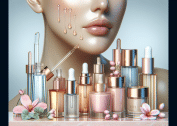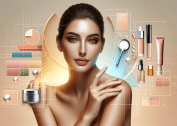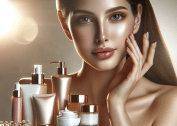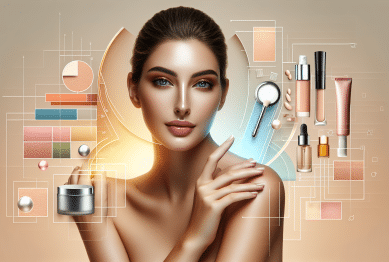Ever wondered what truly works in your quest for glowing skin? This comprehensive guide dives into innovative routines, science-backed habits, and insider secrets to elevating your wellness and beauty game—no matter your skin type or routine complexity.
Understanding What Glowing Skin Really Means
When people talk about ‘glowing skin,’ they often picture a clear, radiant, and hydrated complexion. Though these characteristics seem straightforward, achieving them involves much more than applying the latest trending products. Often, the foundation for radiant skin comes from consistently following a healthy lifestyle. Hydration, sleep quality, and balanced nutrition are frequently cited factors. While some may think topical applications alone are effective, many dermatology experts highlight the importance of holistic wellness. A combination of daily care, hydration, and healthy habits paves the way to skin that naturally glows from within by reducing inflammation and promoting cell renewal. (Source: https://www.aad.org/public/everyday-care/skin-care-basics/care)
It’s no secret that prevention plays a central role in skincare. Environmental factors like UV exposure, pollution, and climate impact how your skin looks and feels. Using broad spectrum sunscreen maintains your complexion’s radiance and can help reduce future spots. But glowing skin is not a fixed condition—it’s dynamic and changes with seasons, hormones, and stress. Mindfulness techniques such as meditation and conscious self-care are increasingly recognized as part of cultivating a visible glow. People who embrace an integrative approach, combining science and self-kindness, often report better long-term outcomes.
Beyond external appearance, glowing skin is closely tied to internal wellness. Experts stress the significance of stress management, sleep hygiene, and maintaining gut health to support your skin’s natural radiance. A comprehensive routine might incorporate antioxidant-rich foods, gentle cleansers, and hydration boosters. Over time, this optimal blend promotes both surface-level luminosity and deeper health benefits. Ultimately, understanding that skin’s glow is the result of lifestyle, not just topical care, provides a powerful sense of agency and can motivate continual self-investment. (Source: https://www.health.harvard.edu/staying-healthy/eat-yourself-beautiful)
Lifestyle Choices That Influence Skin Radiance
Nutrition is a core element impacting how your skin appears. Incorporating whole foods like leafy greens, berries, nuts, and fatty fish introduces vitamins and antioxidants crucial for a healthy complexion. These nutrients combat oxidative stress, which is a hidden culprit behind dull appearance and fine lines. Drinking enough water daily, often underestimated, also keeps skin plump and glowy. Simple swaps—like green tea over sugary drinks—have a cumulative positive effect. Choosing hydration, variety, and moderation can visibly enhance your natural glow, even more than most expensive serums. (Source: https://www.hsph.harvard.edu/nutritionsource/nutrition-and-healthy-skin/)
Exercise is another factor often overlooked in skin health. Movement boosts circulation, which means more nutrients and oxygen reach skin cells. Increased blood flow also supports detoxification, gently clearing away dullness and reviving tired-looking complexions. Many individuals notice an immediate post-workout glow—the so-called ‘exercise flush.’ Over time, regular exercise helps minimize inflammation and regulate hormones, leading to reduced breakouts and more even tone. Whether it’s brisk walking, yoga, or cardio, adding consistent physical activity gives your skin a visible boost.
Quality rest supports your quest for glowing skin. During sleep, your body repairs itself, including replenishing skin cell turnover and repairing minor damage. Sleeping six to eight hours nightly is linked to improved elasticity, fewer dark circles, and a brighter overall appearance. Research shows that ongoing sleep deprivation can contribute to dullness, premature aging, and increased stress hormones, all of which challenge skin clarity. Sleep is a low-cost, powerful strategy for an age-defying glow. Simple changes in your evening routine, like winding down without screens, can yield unexpectedly radiant results. (Source: https://www.sleepfoundation.org/physical-health/skin-health)
The Science Behind Effective Skincare Routines
Building a successful skincare routine begins with understanding your own skin type and needs. While there’s no universal formula, experts consistently recommend gentle cleansing, daily moisturizing, and targeted serums. Ingredients like hyaluronic acid, vitamin C, and niacinamide are proven to enhance moisture retention and boost radiance. Studies highlight that products containing antioxidants help defend skin against environmental damage, supporting a more luminous look. Regular exfoliation—performed appropriately—also removes dead skin, uncovering new layers for a healthy shine. This approach keeps routines simple yet highly effective. (Source: https://www.niams.nih.gov/health-topics/skin-care)
Understanding ingredient labels is key to maximizing any routine. Avoiding harsh soaps, heavy fragrance, or alcohol-based products can preserve the skin barrier, protecting your natural glow. Dermatologists advise observing how products interact with your skin over a few weeks, as visible changes take time. Layering light serums under richer creams ensures targeted treatments absorb without weighing skin down. Sunscreen is a non-negotiable step, offering the dual benefit of protection and long-term radiance. Consistency outweighs novelty—sticking to tried, research-backed products minimizes irritation and maximizes glow.
Periodic treatment with face masks, chemical exfoliants, or home devices can supplement your routine. These extras, when thoughtfully used, encourage radiance and target stubborn concerns like uneven tone or congestion. Professionals recommend patch testing new additions and introducing only one at a time for best results. While it’s tempting to chase fast fixes, sustainable glow results from smart, cumulative habits. Skincare routines anchored in research build lasting changes and support your skin’s best possible days. (Source: https://www.fda.gov/consumers/consumer-updates/skin-care-products-what-know)
Emerging Trends and Natural Alternatives for Beauty
Interest in ‘clean beauty’ continues to grow, with more consumers choosing gentle, plant-based products for their routines. Botanical extracts like aloe vera, chamomile, and green tea are common for calming and brightening the skin. Advocates appreciate these for their simplicity and minimal risk of irritation. However, it’s important to remember not all natural products are gentle—some can be potent and require proper patch testing. Science-backed blends of traditional remedies and modern research create effective, trusted solutions. This hybrid model balances innovation and safety, preserving your skin’s health and glow. (Source: https://www.ncbi.nlm.nih.gov/pmc/articles/PMC5796020/)
Many wellness enthusiasts are exploring rituals like facial massage, gua sha, and lymphatic drainage. These hands-on practices encourage blood flow, reduce puffiness, and often leave the skin looking instantly revived. Incorporating simple tools such as rollers or massagers amplifies product absorption and creates a mindful self-care routine. While evidence varies, some studies note enhanced skin elasticity and improved cheek contour after regular gentle pressure techniques. People combining these rituals with hydration and sleep often report the most noticeable results, making them a smart, low-effort addition to beauty routines.
DIY treatments—ranging from homemade oatmeal masks to honey-based cleansers—remain popular as individuals seek affordable and customizable options. However, dermatologists caution that not every kitchen ingredient is suitable for skin use. Citrus and essential oils, for example, can sometimes cause irritation or sensitivity. Stick to well-tolerated, evidence-supported options for the safest outcome. Combining select home remedies with proven commercial products brings out the best in both worlds, maintaining vibrant, touchably soft skin without unnecessary risk. (Source: https://www.aad.org/public/everyday-care/skin-care-secrets/choosing-products)
Common Skin Challenges and Solutions for All Types
Skin can go through phases—oily, dry, sensitive, or a mix of all three. Addressing each requires an adaptable approach. Oily skin responds well to lightweight, non-comedogenic moisturizers and gentle foaming cleansers. Dry types benefit from rich creams packed with ceramides and regular, targeted exfoliation. For sensitive skin, simple, fragrance-free routines support barrier repair and comfort. Common concerns like hyperpigmentation, acne scars, or redness often improve with the addition of antioxidants and sun protection. (Source: https://www.aad.org/public/diseases/a-z/acne-overview)
For those dealing with stubborn breakouts or irritation, patience and consistency are crucial. Spot treatments featuring salicylic acid or benzoyl peroxide may help, but only if used as directed. Overuse can dry or damage your skin’s protective barrier, so moderation is best. Mild cleansers and occasional professional advice ensure the right management of difficult cases. Whether aiming for spot correction or all-over clarity, supporting your skin’s natural healing can take time but leads to longer-lasting brightness and resilience.
Mature skin presents unique needs, often demanding targeted support for moisture and elasticity. Introducing peptides, retinoids, and extra hydration can boost collagen synthesis and firmness. Sun protection remains a vital habit at any age, helping prevent further spots and damage. Combining lifestyle adjustments—like more sleep and stress reduction—with age-appropriate serums yields significant improvement in glow and smoothness. This adaptive care model meets skin where it is, evolving with changing needs and empowering confidence at every stage.
Building a Sustainable Wellness and Beauty Ritual
Cultivating lasting habits means choosing steps you can enjoy every day. Start with a basic morning and evening routine tailored to what your skin shows it needs. Gradually layer in targeted treatments or wellness practices, like meditation and mindful eating. Documenting your progress with journals or photos can reveal subtler changes. Many find that engaging more fully with self-care supports not only external beauty, but also holistic health.
Celebrating progress—no matter how small—makes the journey enjoyable and helps routines stick. Tracking energy levels, sleep patterns, and hydration alongside skin changes uncovers what works. This approach also builds resilience for when setbacks arise, like breakouts or periods of stress. Instead of chasing quick results, focus on sustainability and self-compassion, knowing each step taken contributes to long-term beauty and wellness. Support communities often exist online and can offer encouragement and new ideas to keep your glow going strong.
Wellness and beauty rituals can adapt over time. Listen to your body and embrace seasonal changes, new research, and feedback from your skin. Ultimately, the goal is to feel comfortable, healthy, and vibrant in your skin every day. The pursuit of glowing skin becomes a celebration of self-investment, learning, and mindful living, rather than a chase for perfection. (Source: https://www.ncbi.nlm.nih.gov/pmc/articles/PMC6017965/)
References
1. American Academy of Dermatology. (n.d.). Skin Care: How to care for your skin. Retrieved from https://www.aad.org/public/everyday-care/skin-care-basics/care
2. Harvard Health Publishing. (n.d.). Eat yourself beautiful. Retrieved from https://www.health.harvard.edu/staying-healthy/eat-yourself-beautiful
3. Harvard T.H. Chan School of Public Health. (n.d.). Nutrition and healthy skin. Retrieved from https://www.hsph.harvard.edu/nutritionsource/nutrition-and-healthy-skin/
4. National Institute of Arthritis and Musculoskeletal and Skin Diseases. (n.d.). Skin care. Retrieved from https://www.niams.nih.gov/health-topics/skin-care
5. U.S. Food & Drug Administration. (n.d.). Skin Care Products: What to Know. Retrieved from https://www.fda.gov/consumers/consumer-updates/skin-care-products-what-know
6. National Institutes of Health. (n.d.). Herbal cosmetics and cosmeceuticals: An overview. Retrieved from https://www.ncbi.nlm.nih.gov/pmc/articles/PMC5796020/









